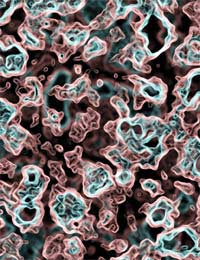How Many Types of Bacteria Are There?

In 1998, an American microbiologist worked out that the number of bacteria on Earth at that time was five million trillion trillion. This is the number 5 followed by thirty zeroes – an impossible number to comprehend. Fortunately, all of these bacteria are grouped into a much smaller number of types.
The Two Main Groups
Taking a big overview of bacteria, there are two main groups, the bacteria and the cyanobacteria. Bacteria include all of the commonly known species such as Escherichia coli (E. coli bacteria), Salmonella bacteria, Staphylococci, Listeria and the Clostridia. Cyanobacteria form a separate type of bacteria that are able to photosynthesise – they can also be called blue-green algae.Cyanobacteria still exist in large numbers today but their importance in the development of life on Earth is due to their existence here millions of years ago. Cyanobacteria were very successful and grew everywhere. Their ability to photosynthesise created all the oxygen that is in our atmosphere today. Most living organisms today depend on oxygen and without cyanobacteria, it is very unlikely that this life would have evolved.
Types of Bacteria
There are seven main groups of bacteria, distinguished by their shape and the type of cell wall they possess. Four of the seven types make up the majority of all bacteria:- Gram positive cocci
- Gram negative cocci
- Gram positive bacilli
- Gram negative bacilli
Cocci are spherical cells, bacilli are rod-shaped. Bacteria of either shape that have thick cell walls are termed gram positive because of the way they take up the Gram stain. Those with thin cell walls are termed gram negative. These four main types are described in more detail below.
There are also three other, more rare types of bacteria:
- Spirochaetes: corkscrew-shaped bacteria that fall into three species, all of which cause specific diseases. Treponema bacteria cause syphilis and yaws, Leptospira bacteria cause leptospirosis and Borrelia bacteria cause Lyme disease.
- Rickettsia: bacteria from the Rickettsiaceae family, which can only live and survive inside other living cells. One type causes the disease typhus.
- Mycoplasma: bacteria that have no cell wall. These can infect humans and cause pneumonia.
Gram Positive Bacteria
The gram positive cocci include the well known species Staphylococcus and Streptococcus. Bacteria from both species fall into the category of friendly bacteria; they do no harm and perform useful functions in the human body and in the environment. Some species can also be pathogenic. Staphylococcus aureus can cause impetigo and scalded skin syndrome, food poisoning and toxic shock syndrome. Streptococcus pyogenes is the culprit usually responsible for tonsillitis and severe sore throats (‘strep throat’), but it can cause many other infections.Gram positive bacilli include Corynebacterium diphtheriae, which causes diphtheria, Listeria monocytogenes, found in unpasteurized dairy products and responsible for dangerous infectious in pregnant women, and bacteria from the species Lactobacillus, friendly bacteria found in the gut.
This group also includes two of the most dangerous types of bacteria known to humans. One is the Bacillus species that causes anthrax, and the other is Clostridium. One Clostridium species causes tetanus, another leads to botulism, a deadly form of food poisoning.
Gram Negative Bacteria
There are two main types of gram negative cocci, both belonging to the genus Neisseria. Neisseria meningitidis causes a form of meningitis, Neisseria gonorrhoeae causes the sexually transmitted infection gonorrhae. The two species are more commonly called the meningococcus and the gonococcus.Gram negative bacilli are a large and varied group that are subdivided into several further categories. The Enterobacteria include many species that cause food poisoning in humans – E. coli, Salmonella, Shigella, Proteus, and also the plague bacterium Yersinia pestis. The Vibrio group contain bacteria that are shaped more like commas than rods – and include the bug that is responsible for cholera.
Helicobacter pylori (H. pylori) is also a gram negative bacillus. This bacterium has been identified in the last 25 years as a major cause of stomach ulcers.
Other gram negative bacilli are Haemophila influenzae, which causes pneumonia, Bordetella pertussis, which causes whooping cough, and Brucella bacteria, which are associated with brucellosis in cattle. A final group is the Bacteroides, a species of bacteria that are very common in the human gut. In fact, they make up a quarter of the dead bacteria in faeces.


Re: Friendly Bacteria in the Digestive System
hello, thankyou for this website it was very helpful
Re: Friendly Bacteria in the Digestive System
nope im leaving now goodbye , mumm! crimble crumble ready?
Re: Friendly Bacteria in the Digestive System
The meat out of the bin is perfectly fine jackie!
Re: Friendly Bacteria in the Digestive System
Yeahhh jim not the right time were quite busy at the moment
Re: How Can People Catch Lyme Disease?
My symptoms of Lyme disease occurred in 2017, but was diagnosed in 2019. I had severe symptoms ranging from headache,…
Re: Friendly Bacteria in the Digestive System
kids
Re: Friendly Bacteria in the Digestive System
i like kids
Re: Friendly Bacteria in the Digestive System
I have yo kidz. i have the basement kids
Re: Friendly Bacteria in the Digestive System
oh god im out
Re: Friendly Bacteria in the Digestive System
uhm